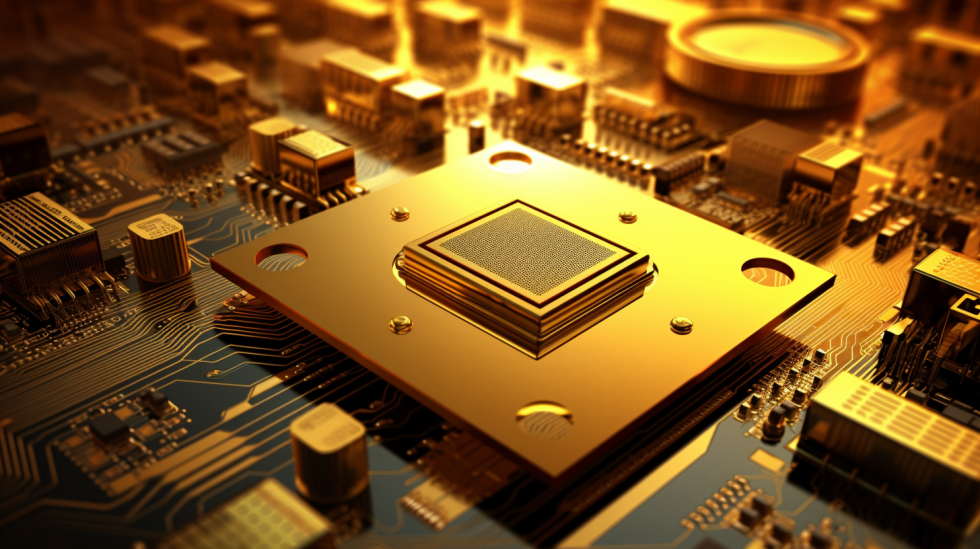In the age of technology, gold plays an invaluable role behind the scenes. While we often associate gold with jewelry and currency, it also has a less visible, yet equally important, role in electronics. From your smartphone and laptop to satellites orbiting the Earth, gold is a critical component that ensures the reliability and performance of electronic devices. In this exploration of “Gold in Electronics,” we’ll uncover the fascinating ways in which this precious metal contributes to the electronic devices that have become an integral part of our lives.

The Role of Gold in Electronics
Gold’s unique properties make it an ideal choice for various electronic applications. Its exceptional conductivity, resistance to corrosion, and malleability have made it indispensable in the world of electronics. Let’s delve into the key roles that gold plays in electronic devices.
1. Electrical Conductivity: Gold is an excellent conductor of electricity, surpassed only by silver. Its low electrical resistance allows for efficient flow of electrical currents, which is crucial in electronic circuits.
2. Corrosion Resistance: Unlike many other metals, gold does not corrode or tarnish. This property ensures that gold-plated connectors and contacts maintain their integrity over time, preventing signal degradation and ensuring long-term reliability.
3. Malleability: Gold is highly malleable, meaning it can be easily shaped into intricate forms, making it ideal for use in fine wires and delicate components in electronic devices.
4. Reliability: Gold’s stability and resistance to oxidation make it a reliable choice for connectors, contacts, and switches that need to maintain electrical conductivity without degradation over extended periods.
Gold in Connectors and Contacts
One of the most common and crucial uses of gold in electronics is in connectors and contacts. These components establish and maintain electrical connections within electronic devices. Gold’s properties make it the material of choice for these critical parts.
1. Connectors: The connectors in your smartphone, computer, and other electronic devices often have gold-plated contacts. These connectors ensure a reliable electrical connection when you plug in headphones, charging cables, or peripheral devices.
2. Contacts: Inside electronic switches, relays, and integrated circuits (ICs), gold is used for the contacts. Gold’s corrosion resistance and excellent conductivity ensure that these components function flawlessly, even with millions of switching cycles.
3. Memory Devices: Gold is used in memory devices like SIM cards and SD cards. The gold contacts on these cards maintain reliable connections and data transfer rates.
Gold in Printed Circuit Boards (PCBs)
Printed Circuit Boards (PCBs) are the backbone of electronic devices. They provide the physical structure and electrical pathways for components to interact. Gold serves various essential roles in PCBs:
1. Gold Plating: PCBs often have gold-plated traces and pads. Gold’s conductivity ensures efficient signal transmission, while its corrosion resistance helps maintain signal integrity over time.
2. Edge Connectors: The edge connectors on PCBs, which interface with connectors on other PCBs or devices, frequently have gold contacts. These connectors require stable, reliable connections for data transfer.
3. Reliability: Gold’s stability is crucial in PCBs, especially in critical applications like aerospace, where electronic components must function reliably under extreme conditions.
Gold in Semiconductors and Microelectronics
The world of microelectronics relies on the precision and reliability of gold. Whether it’s in integrated circuits, transistors, or microchips, gold contributes significantly to the performance and longevity of these components.
1. Bonding Wires: Inside microchips, tiny gold wires are used for wire bonding. These wires connect semiconductor devices to the package or substrate, ensuring proper electrical connections.
2. Die Attach: Gold is also used in the die-attach process, where semiconductor chips are attached to their packaging. Gold’s thermal conductivity helps dissipate heat, preventing damage to the chip.
3. IC Packaging: Gold is used in the packaging of integrated circuits (ICs). Gold-plated leadframes and pins provide electrical connections and protection for the delicate silicon chips within.
Gold in Aerospace and Space Exploration
The demands of aerospace and space exploration require materials that can withstand extreme conditions and provide uninterrupted functionality. Gold is a vital component in these high-stakes environments.
1. Satellites: Gold is used extensively in satellite technology. Gold-coated Mylar, a thin, lightweight material, is used as a protective thermal blanket, reflecting solar radiation and preventing extreme temperature fluctuations.
2. Spacecraft: In spacecraft and space probes, gold-coated surfaces protect against radiation and temperature extremes. The gold’s ability to reflect sunlight helps maintain a stable temperature.
3. Electrical Contacts: Gold is used for electrical contacts in spacecraft and satellites, where reliability is paramount. It ensures that critical systems continue to function in the vacuum of space.
Gold Recycling in Electronics
Given the ubiquity of gold in electronics, recycling has become an important aspect of electronic waste management. Gold recovery from old electronics not only conserves a valuable resource but also reduces the environmental impact of mining.
1. E-Waste Recycling: Discarded electronic devices, also known as e-waste, contain trace amounts of gold. Recycling facilities use various methods to recover gold from old computers, cell phones, and other electronics.
2. Urban Mining: Some companies specialize in “urban mining,” which involves extracting valuable metals like gold from electronic waste on a larger scale. This approach helps reduce the need for new mining operations.
3. Circular Economy: The concept of a circular economy in electronics encourages responsible disposal and recycling of electronic devices, ensuring that valuable materials like gold are recovered and reused.
The Environmental Impact of Gold in Electronics
While gold plays a crucial role in electronics, its extraction and use also raise environmental concerns. Addressing these concerns is essential for the sustainable future of both electronics and the environment.
1. Mining Impact: Gold mining can have significant environmental consequences, including deforestation, habitat disruption, and the release of harmful chemicals. Responsible mining practices and land reclamation efforts are vital.
2. E-Waste Management: Electronic waste disposal and recycling must be handled responsibly to prevent the release of hazardous materials into the environment. Proper recycling and resource recovery are essential.
3. Sustainable Practices: The electronics industry is increasingly focused on sustainable practices, from responsible mining and material sourcing to eco-friendly manufacturing processes and energy-efficient devices.
The Future of Gold in Electronics
As technology continues to advance, the demand for gold in electronics is likely to persist and evolve. Here are some potential developments on the horizon:
1. Miniaturization: As electronic devices become smaller and more compact, the role of gold in microelectronics and miniaturized components is expected to grow.
2. Green Electronics: The industry’s shift towards sustainability may lead to the development of greener alternatives to traditional gold plating and usage in electronics.
3. Circuitry Innovations: Advancements in materials science may lead to new methods of conducting electricity, potentially reducing the reliance on gold in some applications.
4. Recycling Technology: Continued innovation in recycling technology may make it more efficient to recover gold and other valuable materials from electronic waste, reducing the need for primary mining.
5. Space Exploration: As space exploration continues to expand, the use of gold-coated components in spacecraft and satellites will remain critical, contributing to our understanding of the universe.
6. Environmental Responsibility: Electronics manufacturers will likely continue to prioritize environmentally responsible practices, from material sourcing to product disposal.
Conclusion: The Hidden Hero of Electronics
In our increasingly interconnected world, we often take for granted the technology that surrounds us. We marvel at the capabilities of our smartphones, laptops, and spacecraft without giving much thought to the unsung hero working behind the scenes: gold. This precious metal, prized for its beauty and value, silently powers our electronic devices, ensuring that they function reliably and efficiently.
Gold’s exceptional conductivity, resistance to corrosion, and malleability make it the ideal choice for connectors, contacts, and components that underpin the digital age. It ensures that your smartphone can connect to the internet, that your laptop can process complex data, and that satellites can transmit signals across the cosmos.
Yet, as we celebrate the role of gold in electronics, we must also confront the environmental challenges it presents. Gold mining and electronic waste disposal can have negative ecological impacts if not managed responsibly. It is incumbent upon us, as consumers and creators of electronic devices, to advocate for sustainable practices and responsible resource management.
The future of gold in electronics will likely see a continued evolution as technology advances and our understanding of materials deepens. Whether through miniaturization, green alternatives, or innovative recycling technology, gold will continue to be an indispensable part of the electronic devices that shape our lives.
In the heart of the digital revolution, let us not forget the quiet, yet enduring, presence of gold—the precious metal that powers our technology, connects our world, and symbolizes the ever-advancing frontier of human ingenuity.
As we move forward into an era of increased connectivity and technological innovation, may we remain mindful of the precious resources that make it all possible. Gold in electronics is not just an element; it’s a testament to human achievement, a reminder of the power of science, and a symbol of the endless possibilities that await in the world of technology.



